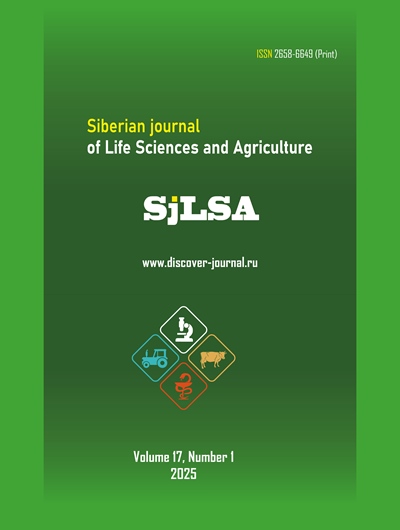Энергоэнтропийный анализ светло-каштановых почв
Аннотация
Энтропия как процесс, изучаемый в природных явлениях, связана с термодинамикой. В частности, при изучении состояния почвы, наблюдается её изменение, проходящее через состояние равновесия. Равновесные состояния в окружающей среде связаны с максимумом полной энтропии.
Цель исследований – определение энергии, заключенной в почве, на различных уровнях в зависимости от фракционного состава частиц почвы на основе эмпирических и расчетных данных.
Новизна. Впервые для орошаемых светло-каштановых почв проведен энергоэнтропийный анализ, позволяющий определить остаточную энергию, запасенную в почве.
Материалы и методы. По полевым данным проведен анализ полного гранулометрического состава почвы с определением весового вклада каждой фракции. Для выделения минералогического состава почвы, использовали расчеты по результатам химического анализа. Наличие гумуса и растительных остатков определяли по общепринятой методике. Отбор образцов осуществлялся на территории п. Водный Волго-Донского междуречья.
Результаты исследований. В исследованиях представлены характеристики светло-каштановой тяжелосуглинистой почвы. Содержание физической глины в пахотном горизонте (2-25 см) – 45,2 %. Иллювиальные горизонты В1 и В2 по содержанию ила выражены четко. Преобладает илистая фракция 27,74 - 31,22 %. Термодинамические характеристики ˗ энтальпия, энергия Гиббса и энтропия не являются абсолютными величинами. Они представляют долю энергии, оставшейся в почве у конкретного минерала, или его свойство. Анализ термодинамических параметров показал, что в горизонте 2-25 см значения (∆H, ∆G, ∆S) наибольшие в крупнопылеватой фракции, затем идет илистая фракция, мелко– , среднепылеватая и песок. На глубине 26-55 см по потенциально высоким термодинамическим параметрам по всем фракциям опережают крупно-пылеватая и илистая. На глубине 56-75 см сохраняется тенденция преобладания крупно-пылеватой и илистой фракции.
Заключение. Самые высокие показатели термодинамических потенциалов в горизонте 25-55см: ∆H, кДж/моль; 1415,6, ∆G, кДж/моль - 1328,22; ∆S, Дж /моль• град - 66,85. Данный горизонт характеризуется максимальными значениями потенциальной относительной остаточной энергии. Самый низкий потенциал глубже 75 см. Энтропия с глубиной уменьшается, в горизонте 25-55см она максимальна.
EDN: DJLXOS
Скачивания
Литература
Список литературы
Волобуев, В. Р., & Пономарев, Д. Г. (1977). Некоторые термодинамические характеристики минеральных ассоциаций почв. Почвоведение, (1), 3–13.
Воронин, А. Д., & Максимова, А. С. (1972). Математический и химический состав фракций механических элементов почв темно-каштановой подзоны. Почвоведение, (8), 112–120.
Ковда, А. В. (1973). Основы учения о почвах. Общая теория общеобразовательного процесса. Москва: Наука. С. 127–148.
Назаров, А. Г. (2004). Термодинамическая направленность почвообразования в истории развития экосистем. В книге: Почвы, биогеохимические циклы и биосфера (с. 70–102). Москва: Товарищество научных изданий КМК.
Палагин, Э. Г. (1981). Математическое моделирование агрометеорологических условий перезимовки озимых культур. Ленинград: Гидрометеоиздат. 191 с.
Яковенко, И. М. (2016). Пространственная структура туристско-рекреационного освоения Крыма: эволюция и перспективы. Учёные записки Крымского федерального университета им. В. И. Вернадского. География. Геология, 2(68), (3), 180–192.
Рулев, А. С., Рулев, Г. А., & Рулева, О. В. (2021). Геотопологическое обоснование создания куртинных насаждений. Siberian Journal of Life Sciences and Agriculture, 13(4), 131–143. https://doi.org/10.12731/2658-6649-2021-13-4-131-143
Bai, B., Yang, G.-C., Li, T., & Yang, G.-S. (2019). A thermodynamic constitutive model with temperature effect based on particle rearrangement for geomaterials. Mechanics of Materials, 139(3), 103180. https://doi.org/10.1016/j.mechmat.2019.103180
Ben-Noah, I., & Friedman, S. P. (2018). Review and evaluation of root respiration and of natural and agricultural processes of soil aeration. Vadose Zone Journal, 17(1), 1–23. https://doi.org/10.2136/vzj2017.06.0119
Rulev, A. S., Ruleva, O. V., Rulev, G. A., & Tanyukevich, V. V. (2021). Landscape and forest reclamation approach to assessing the state of protective forest plantings. Siberian Journal of Life Sciences and Agriculture, 13(5), 321–335. https://doi.org/10.12731/2658-6649-2021-13-5-321-325
Ruleva, O. V., Rulev, G. A., & Rulev, A. S. (2020). Woodlands as a tool for actively managing the microclimate of agrophytocoenoses. International Journal of Pharmaceutical Research, 12(4), 3447–3453. https://doi.org/10.31838/ijpr/2020.12.04.472
Smagin, A. V. (2018). About thermodynamic theory of water retention capacity and dispersity of soils. European Soil Science, 51, 782–796. https://doi.org/10.1134/S1064229318070098
Smagin, A. V. (2016). Thermogravimetric determination of specific surface area for soil colloids. Colloid Journal, 78, 391–396. https://doi.org/10.1134/S1061933Х16030170
Wiesner, S., Starr, G., & Cherry, J. A. (2020). Forest structure and composition drive differences in metabolic energy and entropy dynamics during temperature extremes in longleaf pine savannas. Agricultural and Forest Meteorology, 297, 108252. https://doi.org/10.1016/j.agrformet.2020.108252
Wu, X., Wei, Y., Cai, C., Yuan, Z., Li, D., Liao, Y., & Deng, Y. (2021). Quantifying the contribution of phyllosilicate mineralogy to aggregate stability in the East Asian monsoon region. Geoderma, 393(1), 115036. https://doi.org/10.1016/j.geoderma.2021.115036
Yang, G., & Bai, B. (2019). Thermo-hydro-mechanical model for unsaturated clay soils based on granular solid hydrodynamics theory. International Journal of Geomechanics, 19(10), 04019115. https://doi.org/10.1061/(ASCE)GM.1943-5622.0001498
Zarifi, M., Kvamme, B., & Kuznetsova, T. (2021). Modeling of heat transfer in hydrate-filled sediment systems using residual thermodynamics and classical nucleation theory. Applied Sciences, 11(9), 4124. https://doi.org/10.3390/app11094124
Zhang, Z., & Cheng, X. (2017). A fully coupled THM model based on nonequilibrium. International Journal for Numerical and Analytical Methods in Geomechanics, 41(4), 527–554. https://doi.org/10.1007/978-3-642-32492-5_18
Duan, M. X., & Jin, M. X. (2019). Modeling water and heat transfer in soil-plant-atmosphere continuum applied to maize growth under plastic film mulching. Frontiers of Agricultural Science and Engineering, 6(2), 144–161. https://doi.org/10.15302/J-FASE-2019258
Zhang, Z. (2017). A thermodynamic-based theory for thermo-poromechanical modeling of saturated clays. International Journal of Plasticity, 92(1–2), 164–185. https://doi.org/10.1016/j.ijplas.2017.03.007
References
Volobuev, V. R., & Ponomarev, D. G. (1977). Some thermodynamic characteristics of mineral associations of soils. Soil Science, (1), 3–13.
Voronin, A. D., & Maksimova, A. S. (1972). Mathematical and chemical composition of mechanical fractions of soils in the dark chestnut subzone. Soil Science, (8), 112–120.
Kovda, A. V. (1973). Fundamentals of soil studies. General theory of the educational process. Moscow: Nauka. Pp. 127–148.
Nazarov, A. G. (2004). Thermodynamic direction of soil formation in the history of ecosystem development. In Soils, biogeochemical cycles and biosphere (pp. 70–102). Moscow: Товарищество научных изданий КМК.
Palagin, E. G. (1981). Mathematical modeling of agrometeorological conditions for winter survival of winter crops. Leningrad: Gidrometeoizdat. 191 p.
Yakovenko, I. M. (2016). Spatial structure of tourist-recreational development of Crimea: evolution and prospects. Scientific Notes of Vernadsky Crimean Federal University. Geography. Geology, 2(68)(3), 180–192.
Rulev, A. S., Rulev, G. A., & Ruleva, O. V. (2021). Geotopological justification for creation of curtained plantings. Siberian Journal of Life Sciences and Agriculture, 13(4), 131–143. https://doi.org/10.12731/2658-6649-2021-13-4-131-143
Bai, B., Yang, G.-C., Li, T., & Yang, G.-S. (2019). A thermodynamic constitutive model with temperature effect based on particle rearrangement for geomaterials. Mechanics of Materials, 139(3), 103180. https://doi.org/10.1016/j.mechmat.2019.103180
Ben-Noah, I., & Friedman, S. P. (2018). Review and evaluation of root respiration and of natural and agricultural processes of soil aeration. Vadose Zone Journal, 17(1), 1–23. https://doi.org/10.2136/vzj2017.06.0119
Rulev, A. S., Ruleva, O. V., Rulev, G. A., & Tanyukevich, V. V. (2021). Landscape and forest reclamation approach to assessing the state of protective forest plantings. Siberian Journal of Life Sciences and Agriculture, 13(5), 321–335. https://doi.org/10.12731/2658-6649-2021-13-5-321-325
Ruleva, O. V., Rulev, G. A., & Rulev, A. S. (2020). Woodlands as a tool for actively managing the microclimate of agrophytocoenoses. International Journal of Pharmaceutical Research, 12(4), 3447–3453. https://doi.org/10.31838/ijpr/2020.12.04.472
Smagin, A. V. (2018). About thermodynamic theory of water retention capacity and dispersity of soils. European Soil Science, 51, 782–796. https://doi.org/10.1134/S1064229318070098
Smagin, A. V. (2016). Thermogravimetric determination of specific surface area for soil colloids. Colloid Journal, 78, 391–396. https://doi.org/10.1134/S1061933Х16030170
Wiesner, S., Starr, G., & Cherry, J. A. (2020). Forest structure and composition drive differences in metabolic energy and entropy dynamics during temperature extremes in longleaf pine savannas. Agricultural and Forest Meteorology, 297, 108252. https://doi.org/10.1016/j.agrformet.2020.108252
Wu, X., Wei, Y., Cai, C., Yuan, Z., Li, D., Liao, Y., & Deng, Y. (2021). Quantifying the contribution of phyllosilicate mineralogy to aggregate stability in the East Asian monsoon region. Geoderma, 393(1), 115036. https://doi.org/10.1016/j.geoderma.2021.115036
Yang, G., & Bai, B. (2019). Thermo-hydro-mechanical model for unsaturated clay soils based on granular solid hydrodynamics theory. International Journal of Geomechanics, 19(10), 04019115. https://doi.org/10.1061/(ASCE)GM.1943-5622.0001498
Zarifi, M., Kvamme, B., & Kuznetsova, T. (2021). Modeling of heat transfer in hydrate-filled sediment systems using residual thermodynamics and classical nucleation theory. Applied Sciences, 11(9), 4124. https://doi.org/10.3390/app11094124
Zhang, Z., & Cheng, X. (2017). A fully coupled THM model based on nonequilibrium. International Journal for Numerical and Analytical Methods in Geomechanics, 41(4), 527–554. https://doi.org/10.1007/978-3-642-32492-5_18
Duan, M. X., & Jin, M. X. (2019). Modeling water and heat transfer in soil-plant-atmosphere continuum applied to maize growth under plastic film mulching. Frontiers of Agricultural Science and Engineering, 6(2), 144–161. https://doi.org/10.15302/J-FASE-2019258
Zhang, Z. (2017). A thermodynamic-based theory for thermo-poromechanical modeling of saturated clays. International Journal of Plasticity, 92(1–2), 164–185. https://doi.org/10.1016/j.ijplas.2017.03.007
Просмотров аннотации: 176 Загрузок PDF: 6
Copyright (c) 2025 Gleb A. Rulev, Alexander S. Rulev, Olga V. Ruleva

Это произведение доступно по лицензии Creative Commons «Attribution-NonCommercial-NoDerivatives» («Атрибуция — Некоммерческое использование — Без производных произведений») 4.0 Всемирная.






















































